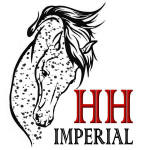|

Imperial
Heritage Horse
In order to be eligible
for the Imperial Book:
All horses must have pedigrees that document the patterned
parents lineage.
All horses must be
HYPP negative (tested or by pedigree).
These horses must be DNA
tested and be verified to their Friesian lineage,
and must a minimum of 25%
Friesian.
"Pattern"
means an Appaloosa or Knabstrupper-type spotted pattern. These
horses are not required to be any particular percentage of these
breeds, but they must have documented "patterned" or "Lp" heritage,
with at least a 3 generation pedigree.
Horses who
have Lp characteristics, with or without an obvious pattern, can
enter the Imperial book.
Horses who have a gray color modifier are not allowed into the
Imperial book. Gray eventually conceals all color and patterns.
Horses from a parent who is a known, or suspected, gray carrier,
must be color tested for gray, before they can be accepted into the
Imperial book. Any horse who is found to have a gray color modifier
will be removed from the Imperial book and placed into the Heritage Horse
book.
Sabino, splash
or other pinto genes are not desirable and are discouraged in the
Imperial book. Pinto genes act as amplifiers of the white pattern in
the Lp patterned horse, which makes true patterns less discernible.
Horses may be no more than 25% draft blood.
Horses that are born solid, with no
visible pattern or lp characteristics, can be entered into the
Imperial Book after the completion of DNA color testing that
confirms they carry at least one copy of PATN or Lp. It
is preferred that as at least one parent has a large spotted blanket pattern, or
is a full or near leopard patterned horse. The PATN1 test was
released by UC Davis on March 10, 2015.
Horse who are few spot
& near few spot horses and are homozygous for Lp have night
blindness. Congenital
Stationary Night Blindness (CSNB) which
is the inability to see in low to no-light conditions. Knowing if
horses are homozygous for leopard complex spotting can help to
inform management decisions." Homozygous LP horses
NOT always appear as few spots and can
have very minimal LP appearance.
Identification Tips:
● A leopard horse is born white from head to hooves with colored
spots the size of a quarter or larger. Leopard horses are born with
the leopard pattern
clearly evident. Horses do not ever "turn into leopards" as they
mature.
● A "false" leopard horse is not born with a full white
pattern. Lp roaning causes the leopard like appearance.
● A near leopard horse is born mostly white with colored spots the
size of a quarter or larger, but has some colored parts on its body
(mostly head and legs). Near leopard horses are
born with the leopard pattern clearly evident. Horses do not ever
"turn into near leopards" as they mature.
● A few spot horse is born white with only a few spots of color on
its entire body.
● A near few spot horse is born with a large pattern of white,
covering most of the body, with a few spots. The head and legs may
be colored.
● A Lp roaned horse is born mostly solid colored and then turns
whiter as it ages, some of these horses may exhibit a leopard-like
pattern,
that develops later in life, usually after the age of 2. However,
these horses are not leopards,
and do not have the genes to produce true leopards, by themselves.
Most Lp roaned horses have colored hairs in
the white of their
body coat.
● Thin
mane and tail hair is common in
horses
that carry the Lp gene,
especially in black based horses.
This lack of hair is caused by the Lp pattern gene and is not caused
by breed. Breeding lp horses
to Friesians will not necessarily
increase the amount of hair in the offspring, if the offspring
inherits Lp.
The Lp gene has the greatest effect on the horses color/patern after the
horse is
over one year of age,
and change can continue for many years
after.
|